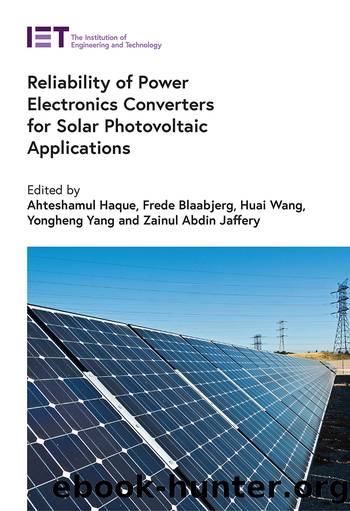Reliability of Power Electronics Converters for Solar Photovoltaic Applications by Haque Ahteshamul;Blaabjerg Frede;Wang Huai;Yang Yongheng;Jaffery Zainul Abdin;

Author:Haque, Ahteshamul;Blaabjerg, Frede;Wang, Huai;Yang, Yongheng;Jaffery, Zainul Abdin;
Language: eng
Format: epub
Publisher: Institution of Engineering & Technology
Published: 2021-08-05T16:00:00+00:00
Figure 5.11âFrequency response of the double-loop control (i.e., the DC-link voltage control loop and the d-axis current control loops) with the designed parameters: (a) open loop Bode plots and (b) closed-loop Bode plots, where BW represents bandwidth of the system
With the above parameters, a two-stage three-phase grid-connected solar inverter system is built up in MATLAB®. Then, the designed controller parameters (i.e., (5.36) and (5.37)) are applied to the three-phase grid-connected solar inverter. Simulation results are shown in Figure 5.12, which includes the performance of the grid line-to-line voltages, the grid currents, the DC-link voltage, and the dq-current components. There are two transient operations in the simulations, i.e., one is a step change in the active power from 0 to 8 kW at t = 0.2 s, and the other is a step change of the reactive power from 0 to 6 kVAR at t = 0.4 s. Specifically, when the input power is changed at t = 0.2 s, the d-axis current fast-tracks the change. As shown in Figure 5.12c, the DC-link voltage appears as a 7.5 percent overshoot and recovers to steady-state after one cycle. Moreover, the q-axis current step change occurs at t = 0.4 s, which can be achieved by directly setting the reactive power reference according to the open-loop control in Figure 5.10. That is an effective and simple reactive power control method under an abnormal grid voltage condition (e.g., the low-voltage ride-through). Furthermore, Figure 5.12e indicates that the q-axis current can regulate quickly when there is a disturbance in the q-axis current, i.e., the step change at t = 0.2 s, which verified the effectiveness of the PI controller for the q-axis current.
Download
This site does not store any files on its server. We only index and link to content provided by other sites. Please contact the content providers to delete copyright contents if any and email us, we'll remove relevant links or contents immediately.
| Automotive | Engineering |
| Transportation |
Whiskies Galore by Ian Buxton(41525)
Introduction to Aircraft Design (Cambridge Aerospace Series) by John P. Fielding(32885)
Small Unmanned Fixed-wing Aircraft Design by Andrew J. Keane Andras Sobester James P. Scanlan & András Sóbester & James P. Scanlan(32569)
Craft Beer for the Homebrewer by Michael Agnew(17928)
Turbulence by E. J. Noyes(7694)
The Complete Stick Figure Physics Tutorials by Allen Sarah(7135)
Kaplan MCAT General Chemistry Review by Kaplan(6591)
The Thirst by Nesbo Jo(6432)
Bad Blood by John Carreyrou(6271)
Modelling of Convective Heat and Mass Transfer in Rotating Flows by Igor V. Shevchuk(6219)
Learning SQL by Alan Beaulieu(6029)
Weapons of Math Destruction by Cathy O'Neil(5824)
Man-made Catastrophes and Risk Information Concealment by Dmitry Chernov & Didier Sornette(5643)
Digital Minimalism by Cal Newport;(5388)
Life 3.0: Being Human in the Age of Artificial Intelligence by Tegmark Max(5182)
iGen by Jean M. Twenge(5158)
Secrets of Antigravity Propulsion: Tesla, UFOs, and Classified Aerospace Technology by Ph.D. Paul A. Laviolette(4980)
Design of Trajectory Optimization Approach for Space Maneuver Vehicle Skip Entry Problems by Runqi Chai & Al Savvaris & Antonios Tsourdos & Senchun Chai(4837)
Electronic Devices & Circuits by Jacob Millman & Christos C. Halkias(4741)
